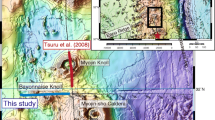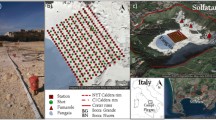Abstract
In September 2001, an extensive active-seismic investigation (Serapis experiment) was carried out in the Gulfs of Naples and Pozzuoli, with the aim of investigating and reconstructing the shallow crustal structure of the Campi Flegrei caldera, and possibly identifying its feeding system at depth. The present study provides a joint analysis of the very shallow seismic reflection data and tomographic images based on the Serapis dataset. This is achieved by reflection seismic sections obtained by the 3D data gathering and through refined P-velocity images of the shallowest layer of Pozzuoli Gulf (z < 1,000 m). From the refined Vp model, the overall picture of the velocity distribution confirms the presence of a complex arc-shaped anomaly that borders the bay offshore. The deeper part of the anomaly (beneath 700 m, with Vp > 3,500 m/s) correlates with units made up of agglomerate tuffs and interbedded lava, which form the southern edge of the caldera, which was probably formed following the two large ignimbritic eruptions that marked the evolutionary history of the area under study. The upper part of the anomaly that tends to split into two parallel arcs is correlated with dikes, volcanic mounds and hydrothermal alteration zones noted in previous shallow reflection seismic analyses. The depth of the transition between the upper and lower parts of the anomaly is characterized by an abrupt Vp increase on the one-dimensional (1D) profiles extracted from the 3D tomographic model and by the presence of a strong reflector located at about 0.6/0.7 s Two Way Time (TWT) on Common Mid Point gathers. The move-out velocity analysis and stack of the P–P and P–S reflections at the layer bottom allowed to estimate relatively high Vp/Vs values (3.7 ± 0.9). This hypothesis has been tested by a theoretical rock physical modeling of the Vp/Vs ratio as a function of porosity suggesting that the shallow layer is likely formed by incoherent, water saturated, volcanic and marine sediments that filled Pozzuoli Bay during the post-caldera activity.








Similar content being viewed by others
References
Acocella V, Cifelli F, Funiciello R (2000) Analogue models of collapse calderas and resurgent domes. J Volcanol Geotherm Res 104:81–96
Acocella V, Funiciello R, Marotta E, Orsi G, De Vita S (2004) The role of extensional structures on experimental calderas and resurgence. J Volcanol Geotherm Res 129:199–217
Agip (1987) Geologia e Geofisica del Sistema Geotermico dei Campi Flegrei. Servizi Centrali per l’ Esplorazione, SERG-MMESG, San Donato, 19 pp
Aster RC, Meyer RP (1988) Three-dimensional velocity structure and hypocentral distribution in the Campi Flegrei caldera, Italy. Tectonophysics 149:195–218
Barberi F, Neri G, Valenza M, Villari L (1991) 1987–1990 unrest at Vulcano. Acta Vulcanologica 1:95–106
Bartole R, Savelli D, Tramontana M, Wezel F (1984) Structural and sedimentary features in the Tyrrhenian margin of Campania, Southern Italy. Marine Geology 55:163–180
Battaglia J, Zollo A, Virieux J, Dello Iacono D (2008) Merging active and passive data sets in traveltime tomography: the case study of Campi Flegrei caldera (Southern Italy). Geoph Prosp. In press
De Vivo B, Rolandi G, Gans PB, Calvert A, Bohrson WA, Spera FJ, Belkin HE (2001) New constraints on the pyroclastic eruptive history of the Campanian volcanic Plain (Italy). Mineral Petrol 73:47–65
Bruno PPG, Cippitelli G, Rapolla A (1998) Seismic study of the Mesozoic carbonate basement around Mt. Somma-Vesuvius, Italy. J Volcanol Geotherm Res 84:311–322
Capuano P, Achauer U (2003) Gravity field modeling in the Vesuvius and Campanian area. In: Zollo A et al (ed) TomoVes Seismic Project: looking inside Mt. Vesuvius. Cuen, Napoli
Cassano E, La Torre P (1987) Geophysics, in Santacroce R (ed), Somma-Vesuvius. CNR Quaderni della Ricerca Scientifica 114(8):175–192
Chiarabba C, Moretti M (2006) An insight into the unrest phenomena at the Campi Flegrei caldera from Vp and Vp/Vs tomography. Terra Nova 18:373–379
D’Argenio B, Pescatore T, Scandone P (1973) Schema geologico dell’Appennino meridionale. Atti dell’ Accademia Nazionale dei Lincei 183:49–72
De Bonitatibus A, Latmiral G, Mirabile L, Palumbo A, Sarpi E, Scalera A (1970) Rilievi sismici per riflessione: strutturali, ecografici (fumarole) e batimetrici del Golfo di Pozzuoli. Boll Soc Nat 79:97–115
Deino AL, Orsi G, Piochi M, de Vita S (2004) The age of the Neapolitan Yellow Tuff caldera-forming eruption (Campi Flegrei caldera—Italy) assessed by 40Ar/39Ar dating method. J Volcanol Geotherm Res 133:157–170
Dvorkin J, Prasad M, Sakai A, Lavoie D (1999) Elasticity of marine sediments: rock physics modeling. Geophys Res Lett 26(12):1781–1784
Finetti I, Morelli C (1974) Esplorazione sismica a riflessione dei Golfi di Napoli e Pozzuoli. Boll Geof Teor Appl 16(62/63):175–222
Florio G, Fedi M, Cella F, Rapolla A (1999) The Campanian Plain and Campi Flegrei: structural setting from potential field data. J Volcanol Geotherm Res 91:361–379
Huffman A, Castagna J (2001) The petrophysical basis for shallow water flow predication using multicomponent seismic data. The Leading Edge 20(9):1030–1052
Ippolito F, Ortolani F, Russo M (1973) Struttura marginale tirrenica dell’ Appennino Campano: reinterpretazione di dati di antiche ricerche di idrocarburi. Mem Soc Geol Ital 12:227–250
Lirer L, Luongo G, Scandone R (1987) On the volcanological evolution of Campi Flegrei. EOS, Trans Am Geophys Union 68:226–234
Judenherc S, Zollo A (2004) The Bay of Naples (Southern Italy): constraints on the volcanic structures inferred from a dense seismic survey. J Geophys Res 109:B10312
Jurkevics A (1988) Polarization analysis of three-component array data. Bull Seismol Soc Am 78(5):1725–1743
Milia A (1998) Stratigrafia, strutture deformative e considerazioni sull’ origine delle unità deposizionale oloceniche del Golfo di Pozzuoli (Napoli). Boll Soc Geol Ital 117:777–787
Milia A, Torrente M (2003) Late-Quaternary volcanism and transtensional tectonics in the Bay of Naples, Campanian continental margin, Italy. Mineralogy and Petrology 79:49–65
Nur A, Marion D, Yin H (1991) Wave velocities in sediments. In: Hovem J, Richardson MD, Stoll RD (eds) Shear waves in marine sediments. Kluwer, Norwell, pp 131–140
Nur A, Mavko G, Dvorkin J, Galmundi D (1995) Critical porosity: the key to relating physical properties to porosity in rocks: Proc 65th Ann Int Meeting. Soc Expl Geophys 878
Orsi G, Scarpati C (1989) Stratigrafia e dinamica eruttiva del Tufo Giallo Napoletano. CNR-GNV Boll 2:917–930
Orsi G, Civetta L, Aprile A, D’Antonio M, de Vita S, Gallo G, Piochi M (1991) The Neapolitan Yellow Tuff: eruptive dynamics, emplacement mechanism and magma evolution of a phreatoplinian-to-plinian eruption. In: Large Ignimbrite Eruptions of the Phlegraean Fields Caldera: The Neapolitan Yellow Tuff and The Campanian Ignimbrite G. Orsi and M. Rosi, Editors, I.A.V.C.E.I. Commission on Explosive Volcanism, Workshop on Explosive Volcanism, Naples, Sept. 1–8, Guideb., pp. 76–115.
Orsi G, D’Antonio M, De Vita S, Gallo G (1992) The Neapolitan Yellow Tuff, a large-magnitude trachytic phreatoplinian eruption: eruptive dynamics, magma withdrawal and caldera collapse. J Volcanol Geotherm Res 53(1–4):275–287
Orsi G, De Vita S, Di Vito M (1996) The restless, resurgent Campi Flegrei nested caldera (Italy): constraints on its evolution and configuration. J Volcanol Geotherm Res 74:179–214
Pescatore T, Diplomatico G, Senatore MR, Tramutoli M, Mirabile L (1984) Contributi allo studio del Golfo di Pozzuoli: aspetti stratigrafici e strutturali. Mem Soc Geol Ital 27:133–149
Rosi M, Sbrana A (1987) Phlegraean Fields. CNR Quaderni della Ricerca Scientifica 114(9):175
Rosi M, Sbrana A, Principe C (1983) The Phlegraean Fields: structural evolution, volcanic history and eruptive mechanisms. J Volcanol Geotherm Res 17:273–288
Scarpati C, Cole P, Perrotta A (1993) The Neapolitan Yellow Tuff: a large volume multiphase eruption from Campi Flegrei, Southern Italy. Bull Volcanol 55:343–356
Tarantola A (2005) Inverse problem theory and methods for model parameter estimation. SIAM, Philadelphia, 342 pp
Vanorio T (2003) Physical properties of volcanic rocks from Campania plain. In: Capuano P, Gasparini P, Zollo A, Virieux J, Casale R, Yeroyanni M (eds) The internal structure of Mt. Vesuvius. A seismic tomography investigation. Liguori, Naples, pp 553–580
Vanorio T, Virieux J, Capuano P, Russo G (2005) Three-dimensional seismic tomography from P wave and S wave microearthquake travel times and rock physics characterization of the Campi Flegrei Caldera. J Volcanol Geotherm Res 110:B03201
Wohletz K, Orsi G, De Vita S (1995) Eruptive mechanism of the Neapolitan Yellow Tuff interpreted from stratigraphic, chemical and granulometric data. J Volcanol Geotherm Res 67:263–290
Zimmer M (2003) Controls on the seismic velocities of unconsolidated sands: measurements of pressure, porosity and compaction effects. Ph.D. thesis, Stanford University, Stanford, CA
Zollo A, Judenherc S (2005) Reply to comment by Rapolla A on The Bay of Naples (southern Italy): constraints on the volcanic structures inferred from a dense seismic survey. J Geophys Res 110:B06308
Zollo A, Judenherc S, Auger E, D’Auria L, Virieux J, Capuano P, Chiarabba C, De Franco R, Ma kris J, Michelini A, and Musacchio G (2003) Evidence for the buried rim of Campi Flegrei caldera from 3-d active seismic imaging. Geophys Res Lett 30(19); DOI 10.1029/2003GL018173
Author information
Authors and Affiliations
Corresponding author
Additional information
Editorial responsibility: M. Ripepe.
Rights and permissions
About this article
Cite this article
Dello Iacono, D., Zollo, A., Vassallo, M. et al. Seismic images and rock properties of the very shallow structure of Campi Flegrei caldera (southern Italy). Bull Volcanol 71, 275–284 (2009). https://doi.org/10.1007/s00445-008-0222-1
Received:
Accepted:
Published:
Issue Date:
DOI: https://doi.org/10.1007/s00445-008-0222-1




